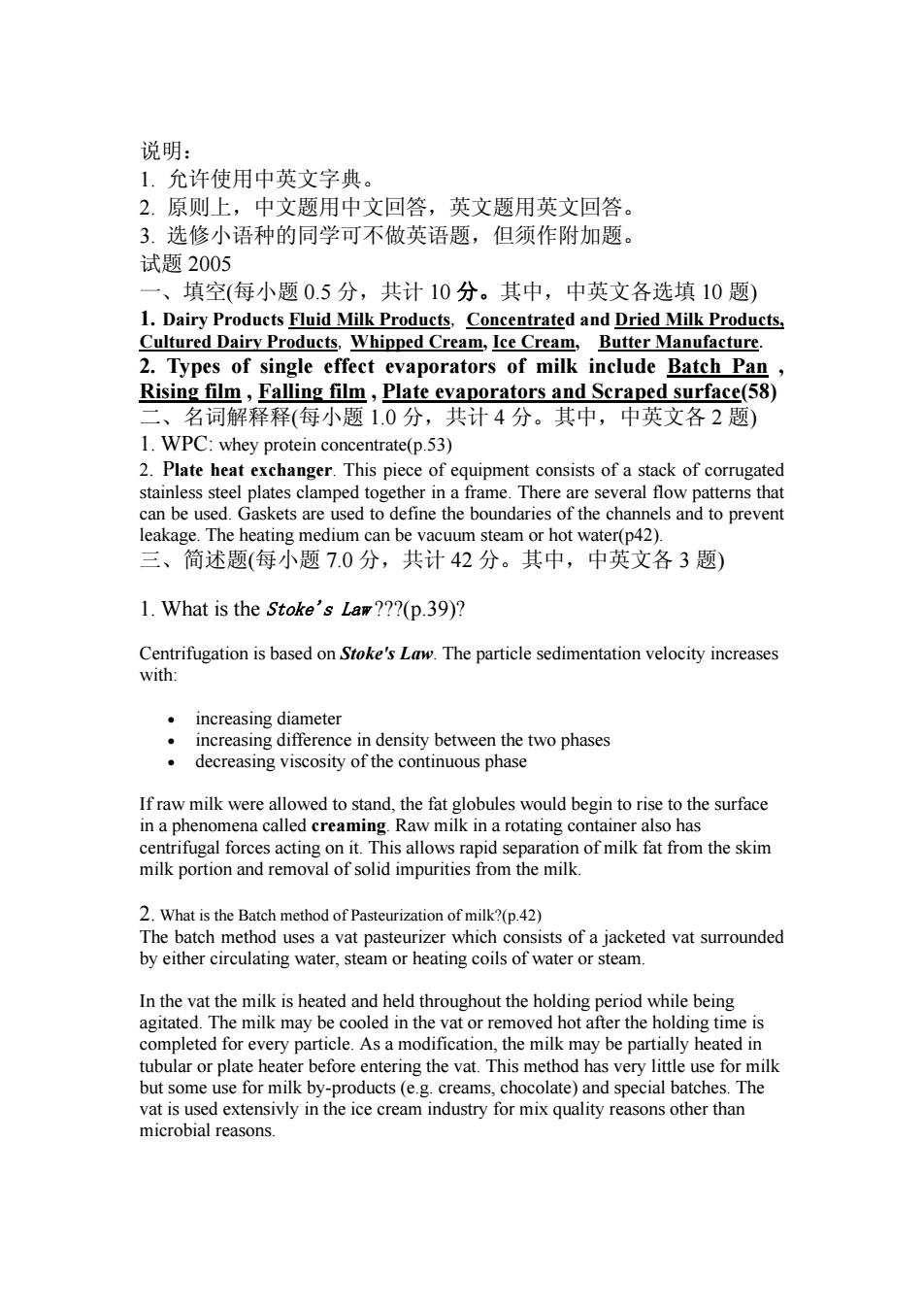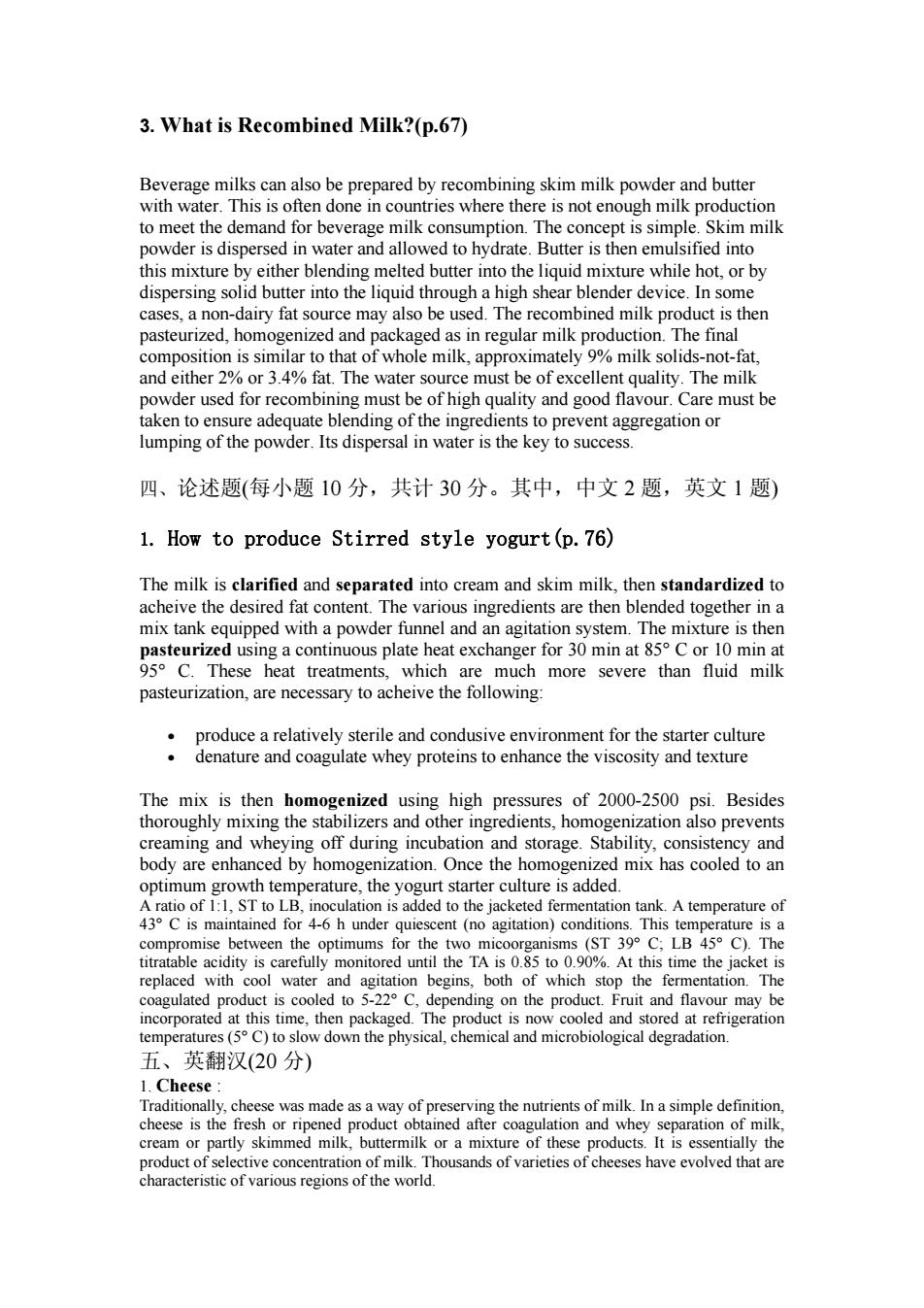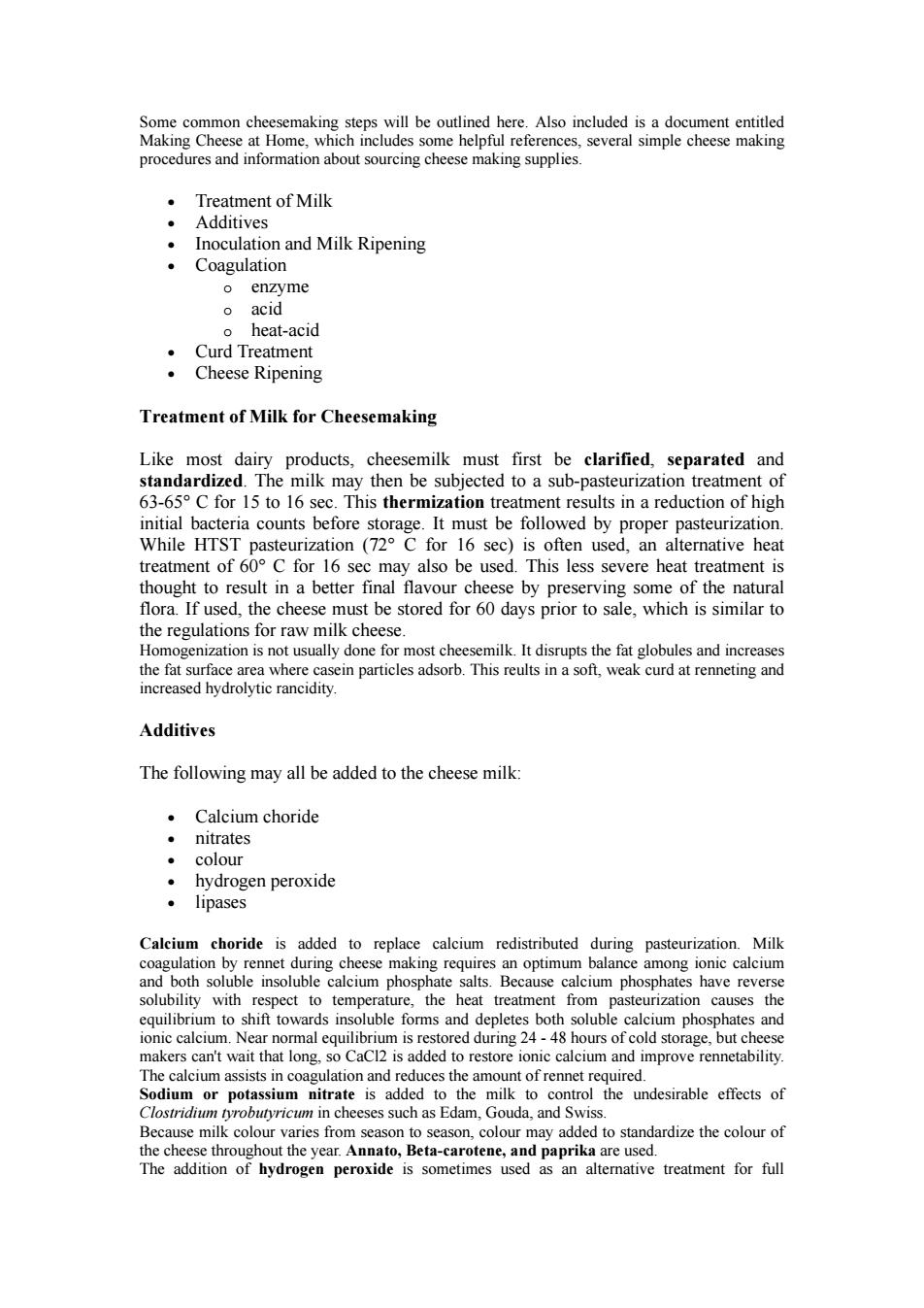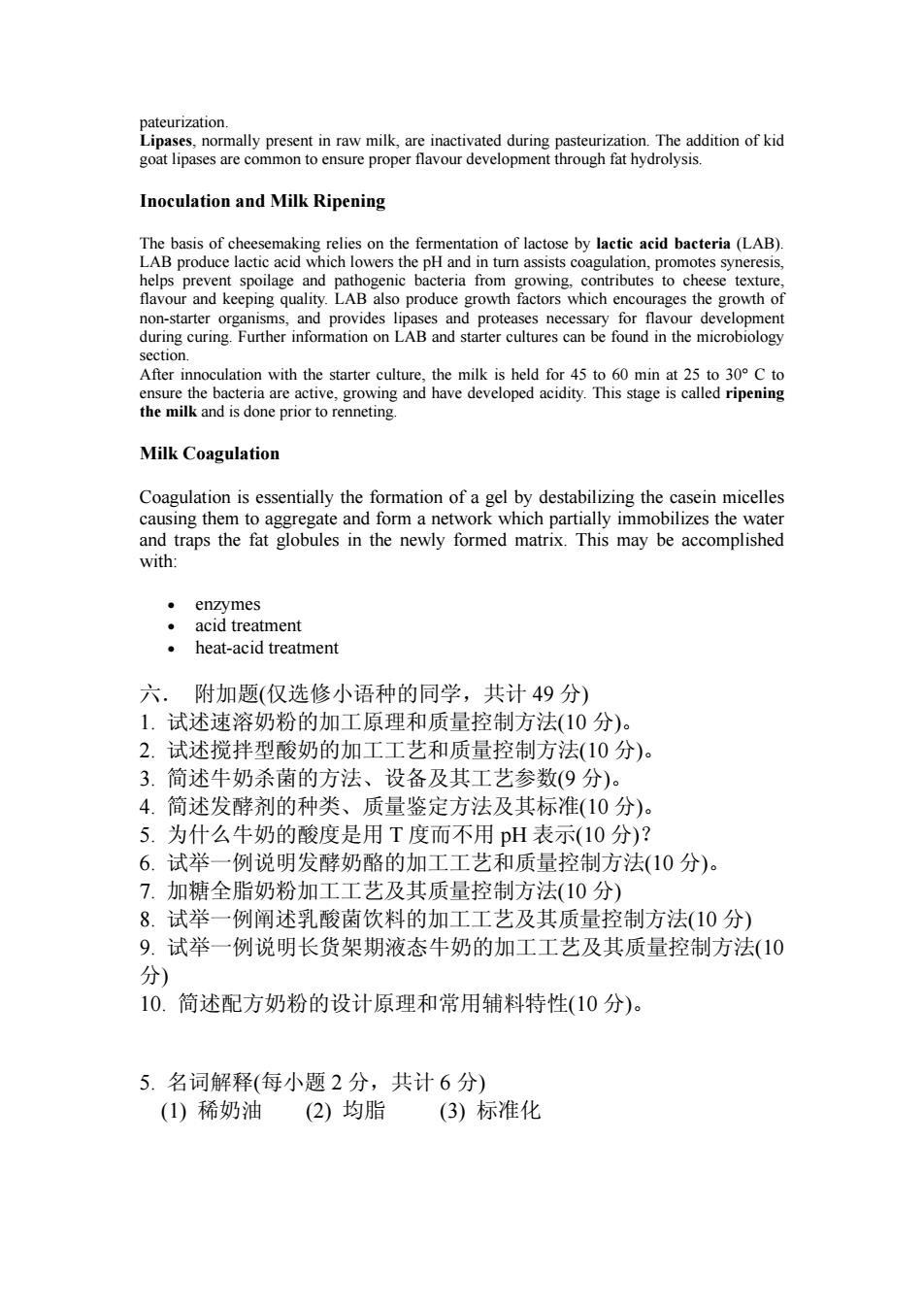
说明: 1.允许使用中英文字典。 2.原则上,中文题用中文回答,英文题用英文回答 3.选修小语种的同学可不做英语题,但须作附加题 试题2005 一、填空(每小题0.5分,共计10分。其中,中英文各选填10题) 1.Dairy Produets Fluid Milk Products,Concentrated and Dried Milk Products Cultured Dairy Products,Whipped Cream,Ice Cream,Butter Manufacture. 2.Types of single effect evaporators of milk include Batch Pan Rising film,Falling film,Plate evaporators and Scraped surface(58) 、名词解释释(每小题1.0分,共计4分。其中,中英文各2题) 1.WPC:whey protein concentrate(p.53) 2.Plate heat exchanger.This piece stainless ent consists of a stack of corru r in T eral flo can be used gaskets are mped to leakage.The heating medium can be vacuum steam or hot water(p2) 三、简述题(每小题7.0分,共计42分。其中,中英文各3题) 1.What is the Stoke's Law???(p.39)? Centrifugation is based on Stoke's Law.The particle sedimentation velocity increases with: ·increasing diameter ·ncreasing c ere nce in density between the two phases decreasing viscosity of the continuous phase If raw wmilk were allo en ph nd rem f solid in m the oI m ilk fat from the skim milk. 2.What is the Batch m ethod of Pasteurization of mi k2p.42) The b vat pa oils of w s of a j acketed vat surrounded y In the yat the milk is heated and held throughout the holding period while being agitated.The milk may be cooled in the vat or removed hot after the holding time is completed for every particle.As a modification,the milk may be partially heated in tubular or plate heater before entering the vat.This method has very little use for milk but some use for milk by-products(e.g.creams,chocolate)and special batches.The vat is used extensivly in the ice cream industry for mix quality reasons other than microbial reasons
说明: 1. 允许使用中英文字典。 2. 原则上,中文题用中文回答,英文题用英文回答。 3. 选修小语种的同学可不做英语题,但须作附加题。 试题 2005 一、填空(每小题 0.5 分,共计 10 分。其中,中英文各选填 10 题) 1. Dairy Products Fluid Milk Products, Concentrated and Dried Milk Products, Cultured Dairy Products, Whipped Cream, Ice Cream, Butter Manufacture. 2. Types of single effect evaporators of milk include Batch Pan , Rising film , Falling film , Plate evaporators and Scraped surface(58) 二、名词解释释(每小题 1.0 分,共计 4 分。其中,中英文各 2 题) 1. WPC: whey protein concentrate(p.53) 2. Plate heat exchanger. This piece of equipment consists of a stack of corrugated stainless steel plates clamped together in a frame. There are several flow patterns that can be used. Gaskets are used to define the boundaries of the channels and to prevent leakage. The heating medium can be vacuum steam or hot water(p42). 三、简述题(每小题 7.0 分,共计 42 分。其中,中英文各 3 题) 1. What is the Stoke's Law ???(p.39)? Centrifugation is based on Stoke's Law. The particle sedimentation velocity increases with: • increasing diameter • increasing difference in density between the two phases • decreasing viscosity of the continuous phase If raw milk were allowed to stand, the fat globules would begin to rise to the surface in a phenomena called creaming. Raw milk in a rotating container also has centrifugal forces acting on it. This allows rapid separation of milk fat from the skim milk portion and removal of solid impurities from the milk. 2. What is the Batch method of Pasteurization of milk?(p.42) The batch method uses a vat pasteurizer which consists of a jacketed vat surrounded by either circulating water, steam or heating coils of water or steam. In the vat the milk is heated and held throughout the holding period while being agitated. The milk may be cooled in the vat or removed hot after the holding time is completed for every particle. As a modification, the milk may be partially heated in tubular or plate heater before entering the vat. This method has very little use for milk but some use for milk by-products (e.g. creams, chocolate) and special batches. The vat is used extensivly in the ice cream industry for mix quality reasons other than microbial reasons

3.What is Recombined Milk?(p.67) Beverage milks cnalso be prepared by recombining skim milk powder and butte the de d fo der is disp ed in wate ed to hydrate.Butter is the ulsified into into the liquid mixture while hot or by dispersing solid butter to the liquid thr ough a high shear blender device in some cases.a non-dairy fat source may also be used.The recombined milk product is then pasteurized,homogenized and packaged as in regular milk production.The final composition is similar to that of whole milk,approximately 9%milk solids-not-fat and either 2%or 3.4%fat.The water source must be of excellent quality.The milk powder used for recombin ng must be of high quality and good flavour.Care must be taken to ensure adequate blending of the ingredients to prevent aggregation or lumping of the powder.Its dispersal in water is the key to success. 四、论述题(每小题10分,共计30分。其中,中文2题,英文1题) 1.How to produce Stirred style yogurt(p.76) The milk is clarified and separated into cream and skim milk,ther the -T uipped con va gredie are r with a powde nnel and the than pasteurizationare more sever to acheive the follo ing nure ndore e the ee The mix is then homogenized using high pressures of 2000-2500 psi.Besides thoroughly mixing the stabilizers and other ingredients,homogenization also prevents creaming and wheying off during incubation and storage.Stability.consistency and body are enhanced by homogenization.Once the homogenized mix has cooled to an temperature.the yogurt sadde 43C is maintained for 4-6 h under o compromise between th optimums for the ansms(ST39° LB 45 C The is o gs oth of which may be co daLetirigeration 五、英翻汉(20分) .Cheese cream or partly skimmed milk,butter It is essentially the Wotetor
3. What is Recombined Milk?(p.67) Beverage milks can also be prepared by recombining skim milk powder and butter with water. This is often done in countries where there is not enough milk production to meet the demand for beverage milk consumption. The concept is simple. Skim milk powder is dispersed in water and allowed to hydrate. Butter is then emulsified into this mixture by either blending melted butter into the liquid mixture while hot, or by dispersing solid butter into the liquid through a high shear blender device. In some cases, a non-dairy fat source may also be used. The recombined milk product is then pasteurized, homogenized and packaged as in regular milk production. The final composition is similar to that of whole milk, approximately 9% milk solids-not-fat, and either 2% or 3.4% fat. The water source must be of excellent quality. The milk powder used for recombining must be of high quality and good flavour. Care must be taken to ensure adequate blending of the ingredients to prevent aggregation or lumping of the powder. Its dispersal in water is the key to success. 四、论述题(每小题 10 分,共计 30 分。其中,中文 2 题,英文 1 题) 1. How to produce Stirred style yogurt(p.76) The milk is clarified and separated into cream and skim milk, then standardized to acheive the desired fat content. The various ingredients are then blended together in a mix tank equipped with a powder funnel and an agitation system. The mixture is then pasteurized using a continuous plate heat exchanger for 30 min at 85° C or 10 min at 95° C. These heat treatments, which are much more severe than fluid milk pasteurization, are necessary to acheive the following: • produce a relatively sterile and condusive environment for the starter culture • denature and coagulate whey proteins to enhance the viscosity and texture The mix is then homogenized using high pressures of 2000-2500 psi. Besides thoroughly mixing the stabilizers and other ingredients, homogenization also prevents creaming and wheying off during incubation and storage. Stability, consistency and body are enhanced by homogenization. Once the homogenized mix has cooled to an optimum growth temperature, the yogurt starter culture is added. A ratio of 1:1, ST to LB, inoculation is added to the jacketed fermentation tank. A temperature of 43° C is maintained for 4-6 h under quiescent (no agitation) conditions. This temperature is a compromise between the optimums for the two micoorganisms (ST 39° C; LB 45° C). The titratable acidity is carefully monitored until the TA is 0.85 to 0.90%. At this time the jacket is replaced with cool water and agitation begins, both of which stop the fermentation. The coagulated product is cooled to 5-22° C, depending on the product. Fruit and flavour may be incorporated at this time, then packaged. The product is now cooled and stored at refrigeration temperatures (5° C) to slow down the physical, chemical and microbiological degradation. 五、英翻汉(20 分) 1. Cheese : Traditionally, cheese was made as a way of preserving the nutrients of milk. In a simple definition, cheese is the fresh or ripened product obtained after coagulation and whey separation of milk, cream or partly skimmed milk, buttermilk or a mixture of these products. It is essentially the product of selective concentration of milk. Thousands of varieties of cheeses have evolved that are characteristic of various regions of the world

Mine h makin urcing Treatment of milk 。Additives Inoculation and Milk Ripening 。Coagulat1on o enzyme o acid heat-acic Curd Treatment Cheese Ripening Treatment of Milk for Cheesemaking dized.Tp oducts.chee ust first be clarified,s ythen be subiected to a sub-p separated and nt of 63-65°Cfor15to16se This thermization tre results in a reduction of high initial hacteria counts hefore stora ge it must he followed by proner While HTST pasteurization(72 C for 16 sec)is often used,an alternative heat treatment of 60 C for 16 sec may also be used.This less severe heat treatment is thought to result in a better final flavour cheese by preserving some of the natural flora.If used,the cheese must be stored for 60 days prior to sale,which is similar to the regulations for raw m Ik cheese the t usually done ilk It disrupts the fat globules n pa orb Thi increased hydrolytic rancidity. in a sof t renneting Additives The following may all be added to the cheese milk Calcium choride Calcium choride is added to replace calcium redistributed during pasteurization.Milk among ionic calcium solubility with res nect to temp rature.the heat treatment from asteurization causes the luble forms and deplete soluble ca m phosphate makers can't wait that long so Cac is added to restore ionic calcium and imp The calcium assists in coag um nitrate is ad desirable effects of Because milk colour varies from season to season,colour may added to standardize the colour of e year.An o.Beta-carotene paprik are us treatment for full
Some common cheesemaking steps will be outlined here. Also included is a document entitled Making Cheese at Home, which includes some helpful references, several simple cheese making procedures and information about sourcing cheese making supplies. • Treatment of Milk • Additives • Inoculation and Milk Ripening • Coagulation o enzyme o acid o heat-acid • Curd Treatment • Cheese Ripening Treatment of Milk for Cheesemaking Like most dairy products, cheesemilk must first be clarified, separated and standardized. The milk may then be subjected to a sub-pasteurization treatment of 63-65° C for 15 to 16 sec. This thermization treatment results in a reduction of high initial bacteria counts before storage. It must be followed by proper pasteurization. While HTST pasteurization (72° C for 16 sec) is often used, an alternative heat treatment of 60° C for 16 sec may also be used. This less severe heat treatment is thought to result in a better final flavour cheese by preserving some of the natural flora. If used, the cheese must be stored for 60 days prior to sale, which is similar to the regulations for raw milk cheese. Homogenization is not usually done for most cheesemilk. It disrupts the fat globules and increases the fat surface area where casein particles adsorb. This reults in a soft, weak curd at renneting and increased hydrolytic rancidity. Additives The following may all be added to the cheese milk: • Calcium choride • nitrates • colour • hydrogen peroxide • lipases Calcium choride is added to replace calcium redistributed during pasteurization. Milk coagulation by rennet during cheese making requires an optimum balance among ionic calcium and both soluble insoluble calcium phosphate salts. Because calcium phosphates have reverse solubility with respect to temperature, the heat treatment from pasteurization causes the equilibrium to shift towards insoluble forms and depletes both soluble calcium phosphates and ionic calcium. Near normal equilibrium is restored during 24 - 48 hours of cold storage, but cheese makers can't wait that long, so CaCl2 is added to restore ionic calcium and improve rennetability. The calcium assists in coagulation and reduces the amount of rennet required. Sodium or potassium nitrate is added to the milk to control the undesirable effects of Clostridium tyrobutyricum in cheeses such as Edam, Gouda, and Swiss. Because milk colour varies from season to season, colour may added to standardize the colour of the cheese throughout the year. Annato, Beta-carotene, and paprika are used. The addition of hydrogen peroxide is sometimes used as an alternative treatment for full

pateurization. Inoculation and Milk Ripening helps prevent spoilage and pathogenic bacteria fo rowing contributes to cheese texture flavour and keeping quality.LAB also produce growth factors which enco rages the growth o section the milk and is done prior to renneting Milk Coagulation Coagulation is essentially the formation of a gel by destabilizing the casein micelles sing th orm a network whic ly imme ilizes the w atment heat-acid treatment 六.附加题(仅选修小语种的同学,共计49分) 1.试述速溶奶粉的加工原理和质量控制方法(10分)。 2.试述搅拌型酸奶的加工工艺和质量控制方法(10分) 3.简述牛奶杀菌的方法、设备及其工艺参数(9分)。 4.简述发酵剂的种类、质量鉴定方法及其标准(10分) 5.为什么牛奶的酸度是用T度而不用pH表示(10分)? 6.试举一例说明发酵奶酪的加工工艺和质量控制方法(10分)。 7.加糖全脂奶粉加工工艺及其质量控制方法(10分) 8.试举一例阐述乳酸菌饮料的加工工艺及其质量控制方法(10分) 9.试举一例说明长货架期液态牛奶的加工工艺及其质量控制方法(10 分分) 10.简述配方奶粉的设计原理和常用辅料特性(10分)。 5.名词解释(每小题2分,共计6分) (1)稀奶油(2)均脂(3)标准化
pateurization. Lipases, normally present in raw milk, are inactivated during pasteurization. The addition of kid goat lipases are common to ensure proper flavour development through fat hydrolysis. Inoculation and Milk Ripening The basis of cheesemaking relies on the fermentation of lactose by lactic acid bacteria (LAB). LAB produce lactic acid which lowers the pH and in turn assists coagulation, promotes syneresis, helps prevent spoilage and pathogenic bacteria from growing, contributes to cheese texture, flavour and keeping quality. LAB also produce growth factors which encourages the growth of non-starter organisms, and provides lipases and proteases necessary for flavour development during curing. Further information on LAB and starter cultures can be found in the microbiology section. After innoculation with the starter culture, the milk is held for 45 to 60 min at 25 to 30° C to ensure the bacteria are active, growing and have developed acidity. This stage is called ripening the milk and is done prior to renneting. Milk Coagulation Coagulation is essentially the formation of a gel by destabilizing the casein micelles causing them to aggregate and form a network which partially immobilizes the water and traps the fat globules in the newly formed matrix. This may be accomplished with: • enzymes • acid treatment • heat-acid treatment 六. 附加题(仅选修小语种的同学,共计 49 分) 1. 试述速溶奶粉的加工原理和质量控制方法(10 分)。 2. 试述搅拌型酸奶的加工工艺和质量控制方法(10 分)。 3. 简述牛奶杀菌的方法、设备及其工艺参数(9 分)。 4. 简述发酵剂的种类、质量鉴定方法及其标准(10 分)。 5. 为什么牛奶的酸度是用 T 度而不用 pH 表示(10 分)? 6. 试举一例说明发酵奶酪的加工工艺和质量控制方法(10 分)。 7. 加糖全脂奶粉加工工艺及其质量控制方法(10 分) 8. 试举一例阐述乳酸菌饮料的加工工艺及其质量控制方法(10 分) 9. 试举一例说明长货架期液态牛奶的加工工艺及其质量控制方法(10 分) 10. 简述配方奶粉的设计原理和常用辅料特性(10 分)。 5. 名词解释(每小题 2 分,共计 6 分) (1) 稀奶油 (2) 均脂 (3) 标准化

分数分布 1.论述题(30分,3题,中文2题,英文1题) 2.英翻汉(20分) 3.简述题(40分,8题,中英文个4题) 4.名词解释(4分,4题,中英文各2题) 5.填空(6分,12题,中英文各6题)
分数分布 1. 论述题(30 分,3 题,中文 2 题,英文 1 题) 2. 英翻汉(20 分) 3. 简述题(40 分,8 题,中英文个 4 题) 4. 名词解释(4 分,4 题,中英文各 2 题) 5. 填空(6 分,12 题,中英文各 6 题)